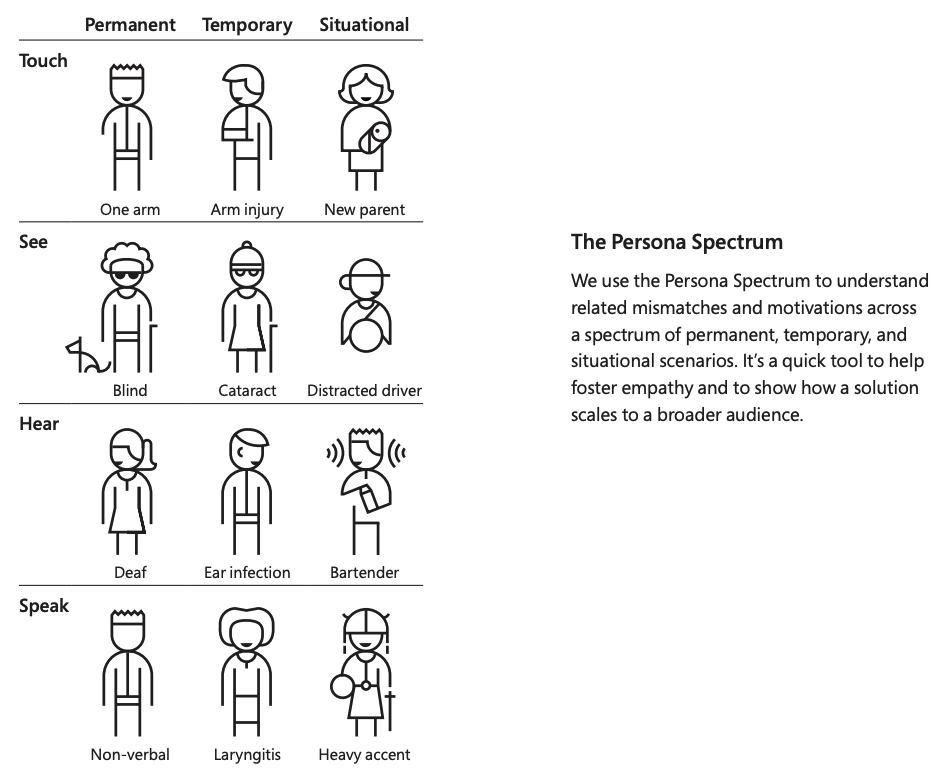Type of Accessibility Issues
Disability is part of being human. Almost everyone will temporarily or permanently experience a disability at some point in their life. Over one billion people – about 15% of the global population – live with some form of disability, and this number is increasing.
The definition underscores that disability is an intrinsic aspect of the human experience, emphasizing individuals' diversity in abilities, knowledge, and skills. This perspective acknowledges that everyone interacts with and perceives their environment, including apps, in unique ways.
Furthermore, the concept of "temporary" disabilities is highlighted, such as the challenges faced during short-term physical impairments like a broken arm or leg. These temporary conditions can alter how one interacts with one's environment for a limited period.
The notion of situational disabilities is also introduced. These are challenges faced in specific scenarios, even if one doesn't have a long-term disability. A practical example is the difficulty of opening a car boot when both hands are occupied, illustrating that accessibility concerns can arise in various situations and contexts.

Disability: A Spectrum, Not a Binary
It is crucial to acknowledge that disability is not a binary condition but a spectrum that spans from mild to severe, with numerous variations and intersections.
For instance, let's take auditory challenges. Some individuals may experience slight hearing loss that can be corrected with the occasional use of a hearing aid, while others may be completely deaf. Similarly, visual impairment refers to decreased vision that cannot be fully corrected with glasses or contact lenses.
Visual
Visual impairment is a reduction in vision that cannot be fully rectified with corrective measures like glasses or contact lenses.
Examples of visual impairments include:
- Visual Acuity (Clarity): The sharpness of vision, determining the ability to see details at near and far distances.
- Light Sensitivity: Difficulty or discomfort in bright light conditions or an increased sensitivity to light sources.
- Contrast Sensitivity: The ability to distinguish between variations of lightness and darkness, affecting the clarity of objects against their backgrounds.
- Field of Vision: The total area an individual can see without moving their eyes, including peripheral vision.
- Color Vision: The ability to perceive and distinguish between different colors can be affected in conditions like color blindness.
Mobility
Mobility impairment refers to conditions that limit an individual's ability to move or coordinate certain movements. This can range from challenges with fine motor skills, like grasping objects, to broader issues, like walking or moving one's limbs.
Examples of mobility impairments:
- Tremor: Involuntary, rhythmic muscle contractions leading to shaking movements in one or more body parts.
- **Lack **of Coordination: Difficulty moving different body parts smoothly and efficiently together.
- Paralysis: Loss of muscle function in a body part, rendering it immobile.
- Amputation: The removal of a body part, especially a limb, either by surgery or trauma.
- Arthritis: Inflammation of the joints, causing pain and difficulty in movement.
Hearing
Hearing impairment refers to a reduced ability to hear, ranging from mild difficulties in picking up certain sounds to a complete loss of hearing.
Examples of hearing impairments:
- **Hard **of Hearing: Refers to individuals who have some degree of hearing loss but may still retain some ability to hear, often requiring the use of hearing aids or other assistive devices.
- Deafness: Indicates a more profound level of hearing loss, where the individual has little to no functional hearing.
Cognitive
Cognitive impairment refers to challenges in mental processes such as memory, attention, learning, and decision-making. Individuals with cognitive impairments might find it difficult to remember information, grasp new concepts, maintain focus, or make decisions that impact their daily activities and interactions.
Examples of mobility impairments:
- **ADHD **(Attention Deficit Hyperactivity Disorder): A neurodevelopmental disorder characterized by inattention, hyperactivity, and impulsivity.
- Autism: A developmental disorder affecting communication and behaviour, often characterized by challenges with social interactions and repetitive behaviours.
- Anxiety: A mental health disorder characterized by excessive fear, worry, or nervousness that can interfere with daily activities.
- Delirium: An abrupt change in the brain that causes confusion and reduced awareness of one's environment.
- Dyslexia: A learning disorder that affects the ability to read, write, and spell despite having average to above-average intelligence.
- Epilepsy: A neurological disorder marked by recurrent, unprovoked seizures.